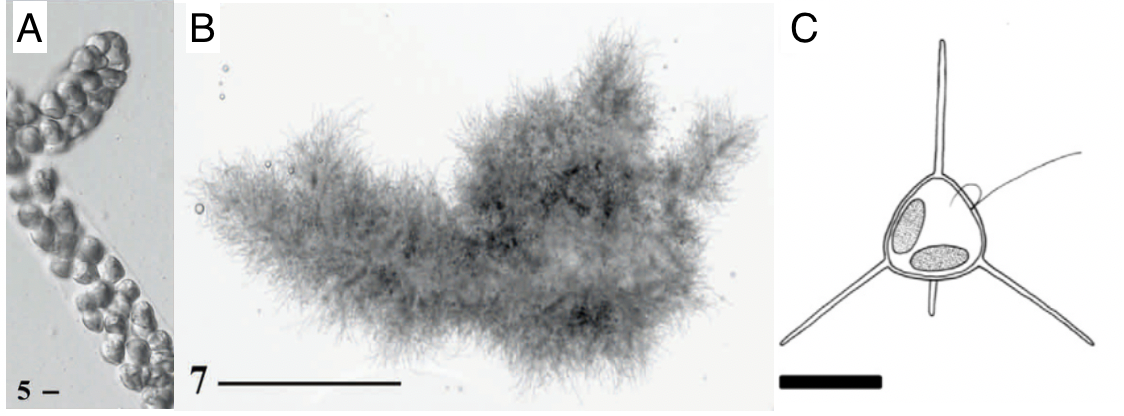|
by Eli Gendron The Chrysophyceae or ‘golden algae’ are a class of yellow-brown pigmented algae who get their pale coloration from the pigment fucoxanthin, which masks the darker greens of chlorophyll a + c, and generally have a motile life cycle stage where single cells develop heterokonts (pair of flagella of unequal length and often perform different functions) (Nicholls and Wujek 2003). Chrysophytes are usually found in freshwater ecosystems and associated with oligotrophic (low nutrient) environments resulting in them acting as the base nutrient source for many heterotrophic organisms (Rawson 1956). Due to their preference for oligotrophic freshwater ecosystems, members of Chrysophyceae are often abundant in the low nutrient waters of alpine lakes, streams, and rivers (Ward 1994). In particular, the Chrysophyte Hydrurus foetidusis commonly observed in glacial melt streams and other environments with low nutrients, high light availability, and rapidly moving water (Moog and Janecek 1991). H. foetidusalso shows a preference for cold water temperatures and temperatures above 16˚C are lethal (Klaveness 2017). H. foetidusis a surface attached multicellular alga (Fig.1A) which grows on stream beds and creates fibrous macro-structures (Fig.1B) which act as residence and food for invertebrate and grazing protist communities (Moog and Janecek 1991). In the attached stage of its life cycle, Hydrurusis non-motile, but when it is ready to colonize new locations, it sheds motile single cells (zoospores, Fig.1C) which possess the characteristic heterokont (Hoffman et al.1986). H. foetidus can also be found across a wide geographic range, including both Antarctica and the Arctic. Lastly, due to its wide geographic range, significant preference for oligotrophic environments, sensitivity to temperature, and its key role in nutrient availability in oligotrophic environments, H. foetidus and its relatives make ideal candidates for indicators to monitor changes in ecosystem health, stability, and trophic status under shifts in climatic conditions (Klaveness 2017).  Figure 1. Morphology of Hydrurus foetidus’ structures. Light microscope pictures of the multicellular structure (A), macrostructure (B), and illustration of the single cell zoospore (C) of Hydrurus foetidus. Scale bars are 5 µm (A), 5 mm (B), and 5 µm (C). Note the diagram of the zoospore (C) includes the heterokont flagella. The heterokont are likely an adaptation to aquatic environments as a way to facilitate the spread of offspring in order to establish new macrostructures downstream. Pictures and figures were adapted from Klaveness 2017 (A, B) and Remias et al. 2013 (C). References:
Hoffman, L.R., Vesk, M., and Pickett-Heaps, J.D. (1986) The cytology and ultrastructure of zoospores of Hydrurus foetidus (Chrysophyceae). Nord. J. Bot. 6: 105–122. Klaveness, D. (2017) Hydrurus foetidus (Chrysophyceae)—an inland macroalga with potential. J. Appl. Phycol.29: 1485–1491. Moog, O. and Janecek, B.F.U. (1991) River flow, substrate type, and Hydrurus density as major determinants of macroinvertebrate abundance, composition and distribution. Int. Vereinigung für Theor. und Angew. Limnol. Verhandlungen24: 1888–1896. Nicholls, K.H. and Wujek, D.E. (2003) Chrysophycean Algae Elsevier Inc. Rawson, D.S. (1956) Algal Indicators of Trophic Lake Types. Limnol. Oceanogr.1: 18–25. Ward, J.V. (1994) Ecology of alpine streams. Freshw. Biol.32: 277–294.
1 Comment
Mihaela Urziceanu
12/9/2021 01:29:30 am
How can I cite this info and the figure, please?
Reply
Leave a Reply. |
AuthorVarious lab members contribute to the MoM Blog Archives
October 2023
Categories |

 RSS Feed
RSS Feed
